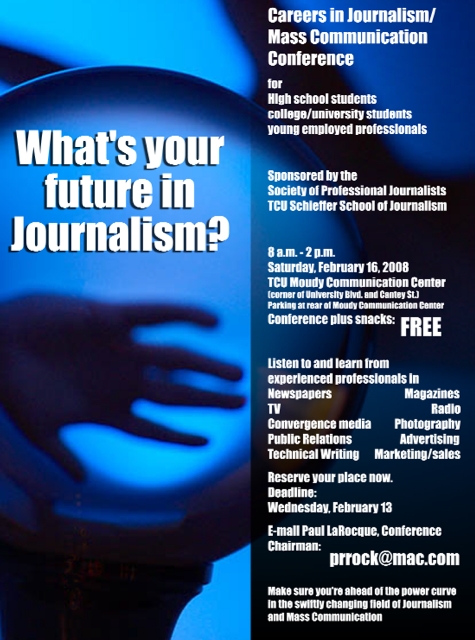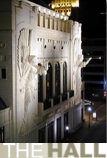





Next month — scenes from a packed partyI
SPJ national update: FCC eases media ownership standard; and judge rules White
House visitor logs are public documents. The FCC, overturning a 32-year-old
ban, voted Dec. 18 to allow broadcasters in the nation’s 20 largest media markets to also own a newspaper. Sen. Byron Dorgan, D-N.D., vowed to introduce legislation to overturn the changes. John Sturm, head of the Newspaper Association of America, called the move a “baby step,” adding that “the record clearly points to full repeal of this rule.” More here. ... White House visitor logs are public documents, a federal judge ruled Dec.
18, rejecting a legal strategy that the Bush administration had hoped would get around public-records laws and let White
House guests remain a secret. More here.
SPJ national update II: New Republic disavows Iraq diarist’s reports; and NBC decides to run conservative-group ad. After nearly five
months of criticism, the New Republic said the magazine had lost faith in the
Army private who wrote of wartime cruelty in Iraq. “We cannot be confident that the events in his pieces occurred in exactly the
manner that he described them,” editor Franklin Foer wrote of the dispatches by Scott Thomas Beauchamp. “Without that essential confidence, we cannot stand by these stories.” More here. ... NBC reversed course Dec. 8 in favor of a conservative group’s ad thanking U.S. troops. The ad asked viewers to remember the troops during
the holidays and then guided viewers to the Freedom’s Watch web site, which NBC initially said was too political. More here.
SPJ national update III: Obama Muslim story “not a deliberate ‘smear job’ “; and
who needs the police when you’ve got mom? Stories about rumors are tricky and easily misconstrued. A Nov. 29
Washington Post story and headline that explored Barack Obama’s “connections to the Muslim world” and rumors that he is Muslim were met with a swift internet reaction that left
some staffers stunned at its ferocity. Even Post editorial cartoonist Tom Toles was “so upset” that he took the unusual step of taking shots at the story in an editorial-page
cartoon. More here. ... A single mother put police and journalists to shame in their attempts to
unravel the reappearance of canoeist John Darwin by using a simple Google search. The woman found the picture that apparently
shows Darwin with his wife in Panama City in July last year. More here.
SPJ national update IV: Parts of Patriot Act thrown out; and FISA court
withholds warrantless wiretapping documents. A federal appeals court ruled Dec.
10 that some portions of the USA Patriot Act dealing with foreign terrorist
organizations are unconstitutional because the language is too vague to be
understood by a person of average intelligence. More here. ... The nation’s spy court said Dec. 11 that it will not release its documents regarding the Bush administration’s warrantless wiretapping program. The Foreign Intelligence Surveillance Court,
in a rare on-the-record opinion, said the public has no right to view the
documents because they deal with the clandestine workings of national-security
agencies. More here.
SPJ national update V: Utah’s top court ponders journalist shield law; and case lays bare the media’s reliance on Iraqi journalists. The Utah Supreme Court is considering what
experts say would be one of the strongest rules in the country shielding
reporters from prosecutors, defense lawyers and judges who would punish them
for refusing to reveal confidential news sources. More here. ... Bilal Hussein, an Iraqi photographer who had a hand in the AP’s 2005 Pulitzer Prize for photography before being jailed without charges by the
U.S. military, finally had a day in court. But his story, which highlights the
unprecedented role that Iraqis are playing in news coverage of the war, is
really just beginning. More here.
SPJ national update VI: Student’s punishment for writing a “terroristic threat” in his notebook upheld; and is America tolerating Muslim hate speech? School
administrators were justified in punishing an El Paso high school student who
wrote a violent story in his notebook, a federal appeals court ruled Nov. 20 in
a decision that free-speech advocates fear could expand officials’ power to censor student expression. A Montwood High School sophomore was
suspended for three days in August 2005 after Assistant Principal
Jesus Aguirre discovered “My Nazi Diary Based on a True Story,” written in the form of a first-person diary, which described the growth of a
neo-Nazi party at high schools in the Socorro Independent School District,
culminating in a Columbine-style shooting at graduation. The student and his
parents maintained that the story was fictional. More here. ... Talk-show host Michael Savage in October telling his listeners that Muslims should be deported and making
rude comments about what they could do with their religion did not create the
furor that knocked radio icon Don Imus off of MSNBC and CBS Radio after he denigrated a black women’s basketball team. That leaves many Muslim-Americans suspicious that Americans
have a double standard when it comes to Islam. “My sense is that you could say anti-Muslim comments that you could never get
away with saying, for example, as anti-Jewish comments,” said Stephen Wessler of the Center for the Prevention of Hate Violence in Portland, Maine. “There’s a much greater public level of acceptance of denigrating Muslims.” More here.
===========================================================
PEOPLE & PLACES
You can lick us, but you can’t keep us down. U.S. postage stamps honoring American journalists Martha Gellhorn, John Hersey, George Polk, Ruben Salazar and Eric Sevareid will be available for purchase nationwide this spring. The first-day-of-issue
dedication ceremony will take place at the National Press Club in Washington,
D.C., as part of activities highlighting the press club’s 100th anniversary. Gellhorn (1908-98) covered the Spanish Civil War, World War
II and the Vietnam War in a remarkable, groundbreaking career. During World War
II, she stowed away on a hospital ship in the D-Day fleet and went ashore as a
stretcher bearer. She was married to
Ernest Hemingway. Hersey’s (1914-93) most famous story, which some proclaim the greatest work of
journalism of the 20th century, describes what happened when the U.S. dropped
an atomic bomb on Hiroshima. Polk (1913-48) was a talented young CBS
correspondent who filed hard-hitting radio bulletins from strife-torn Greece
after World War II. He was working on reports of corruption involving U.S. aid
when he disappeared. His body was found a week later; the circumstances of his
death remain a mystery. Salazar (1928-70) was the first Mexican-American
journalist to have a major voice in mainstream news. His writings in the Los
Angeles Times and segments at KMEX-TV on the Chicano movement in the 1960s
added richly to the historical record. While in Los Angeles covering a Vietnam
War protest, he was shot in the head and killed by a tear gas projectile fired
by a deputy sheriff. Sevareid (1912-92) was a writer for the New York Herald
Tribune and later a broadcast journalist for CBS radio recruited by
Edward R. Murrow. He covered World War II, reporting on the approach of the Germans to Paris,
the exodus from the city and on life in London during wartime. In 1943, en
route to China, he parachuted from a disabled plane and eventually emerged from
the jungle on foot. Journalists Murrow, Ernie Pyle, Walter Lippman, Henry Luce, Nellie Bly, Ida Tarbell, Ethel Payne, Margueritte Higgins and publisher Adolph Ochs also have been commemorated on stamps.





































